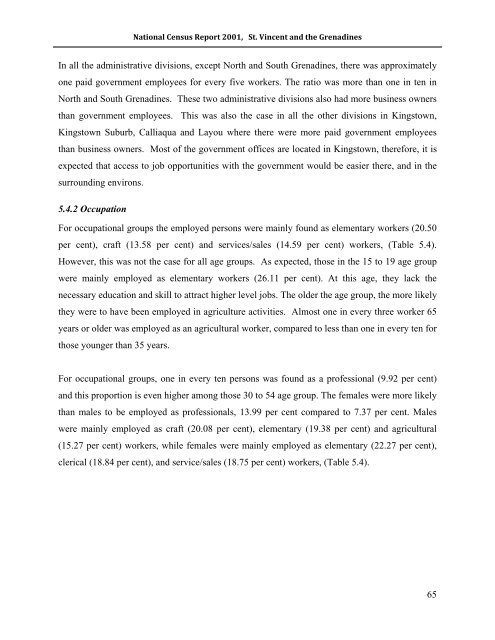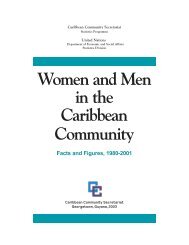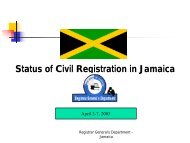National Census Report 2001, St. Vincent and the GrenadinesTable 5.3(b): Employed Population 15 years or Older by Status in Employment, Administrative Divisionand Sex, 2001AdministrativeDivisionPaidEmp.Gov'tPaidEmp.PrivatePaidEmp.StatutaryUnpaidWorkerOwned BusinessW/OhelpWithhelpApprenticeTotal 6,596 18,923 1,061 595 1,800 5,060 32 969 35,036Kingstown 1097 2795 237 37 264 493 6 174 5,103Kingstown Suburb 863 2371 185 41 135 489 3 84 4,171Calliaqua 1590 4514 262 51 421 722 7 342 7,909Marriaqua 503 1402 83 60 166 461 0 55 2,730Bridgetown 379 909 28 49 129 401 2 45 1,942Colonarie 386 1019 44 75 174 393 6 42 2,139Georgetown 373 773 36 105 155 369 1 53 1,865Sandy Bay 112 275 5 42 10 192 0 21 657Layou 355 978 83 17 51 259 2 30 1,775Barrouallie 327 661 42 37 62 373 1 34 1,537Chateaubelair 320 491 23 58 76 575 1 30 1,574North Grenadines 150 1659 15 9 105 185 3 30 2,156South Grenadines 141 1076 18 14 52 148 0 29 1,478Male 3,354 11,764 746 325 1,355 3,380 25 569 21,518Kingstown 503 1503 157 11 184 282 3 93 2,736Kingstown Suburb 454 1408 124 24 105 274 3 50 2,442Calliaqua 740 2554 176 25 293 413 6 188 4,395Marriaqua 267 851 57 32 130 301 0 38 1,676Bridgetown 204 624 19 36 113 332 2 24 1,354Colonarie 201 738 33 46 158 314 4 25 1,519Georgetown 207 553 31 61 115 254 0 34 1,255Sandy Bay 61 213 3 29 8 151 0 10 475Layou 199 674 64 9 43 161 2 21 1,173Barrouallie 195 511 35 14 47 235 1 22 1,060Chateaubelair 191 356 22 26 58 446 1 24 1,124North Grenadines 70 1098 10 7 69 125 3 21 1,403South Grenadines 62 681 15 5 32 92 0 19 906Don’tknowTotalFemale 3,242 7,159 315 270 445 1,680 7 400 13,518Kingstown 594 1292 80 26 80 211 3 81 2367Kingstown Suburb 409 963 61 17 30 215 0 34 1729Calliaqua 850 1960 86 26 128 309 1 154 3514Marriaqua 236 551 26 28 36 160 0 17 1054Bridgetown 175 285 9 13 16 69 0 21 588Colonarie 185 281 11 29 16 79 2 17 620Georgetown 166 220 5 44 40 115 1 19 610Sandy Bay 51 62 2 13 2 41 0 11 182Layou 156 304 19 8 8 98 0 9 602Barrouallie 132 150 7 23 15 138 0 12 477Chateaubelair 129 135 1 32 18 129 0 6 450North Grenadines 80 561 5 2 36 60 0 9 753South Grenadines 79 395 3 9 20 56 0 10 57264
National Census Report 2001, St. Vincent and the GrenadinesIn all the administrative divisions, except North and South Grenadines, there was approximatelyone paid government employees for every five workers. The ratio was more than one in ten inNorth and South Grenadines. These two administrative divisions also had more business ownersthan government employees. This was also the case in all the other divisions in Kingstown,Kingstown Suburb, Calliaqua and Layou where there were more paid government employeesthan business owners. Most of the government offices are located in Kingstown, therefore, it isexpected that access to job opportunities with the government would be easier there, and in thesurrounding environs.5.4.2 OccupationFor occupational groups the employed persons were mainly found as elementary workers (20.50per cent), craft (13.58 per cent) and services/sales (14.59 per cent) workers, (Table 5.4).However, this was not the case for all age groups. As expected, those in the 15 to 19 age groupwere mainly employed as elementary workers (26.11 per cent). At this age, they lack thenecessary education and skill to attract higher level jobs. The older the age group, the more likelythey were to have been employed in agriculture activities. Almost one in every three worker 65years or older was employed as an agricultural worker, compared to less than one in every ten forthose younger than 35 years.For occupational groups, one in every ten persons was found as a professional (9.92 per cent)and this proportion is even higher among those 30 to 54 age group. The females were more likelythan males to be employed as professionals, 13.99 per cent compared to 7.37 per cent. Maleswere mainly employed as craft (20.08 per cent), elementary (19.38 per cent) and agricultural(15.27 per cent) workers, while females were mainly employed as elementary (22.27 per cent),clerical (18.84 per cent), and service/sales (18.75 per cent) workers, (Table 5.4).65
- Page 1:
CARICOM CAPACITY DEVELOPMENTPROGRAM
- Page 4:
National Census Report 2001, St. Vi
- Page 7 and 8:
National Census Report 2001, St. Vi
- Page 9 and 10:
National Census Report 2001, St. Vi
- Page 11 and 12:
National Census Report 2001, St. Vi
- Page 13 and 14:
National Census Report 2001, St. Vi
- Page 15 and 16:
National Census Report 2001, St. Vi
- Page 17 and 18:
National Census Report 2001, St. Vi
- Page 19 and 20:
National Census Report 2001, St. Vi
- Page 21 and 22:
National Census Report 2001, St. Vi
- Page 23 and 24:
National Census Report 2001, St. Vi
- Page 25 and 26:
National Census Report 2001, St. Vi
- Page 27 and 28:
National Census Report 2001, St. Vi
- Page 29 and 30:
National Census Report 2001, St. Vi
- Page 31 and 32: National Census Report 2001, St. Vi
- Page 33 and 34: National Census Report 2001, St. Vi
- Page 35 and 36: National Census Report 2001, St. Vi
- Page 37 and 38: National Census Report 2001, St. Vi
- Page 39 and 40: National Census Report 2001, St. Vi
- Page 41 and 42: National Census Report 2001, St. Vi
- Page 43 and 44: National Census Report 2001, St. Vi
- Page 45 and 46: National Census Report 2001, St. Vi
- Page 47 and 48: National Census Report 2001, St. Vi
- Page 49 and 50: National Census Report 2001, St. Vi
- Page 51 and 52: National Census Report 2001, St. Vi
- Page 53 and 54: National Census Report 2001, St. Vi
- Page 55 and 56: National Census Report 2001, St. Vi
- Page 57 and 58: National Census Report 2001, St. Vi
- Page 59 and 60: National Census Report 2001, St. Vi
- Page 61 and 62: National Census Report 2001, St. Vi
- Page 63 and 64: National Census Report 2001, St. Vi
- Page 65 and 66: National Census Report 2001, St. Vi
- Page 67 and 68: National Census Report 2001, St. Vi
- Page 69 and 70: National Census Report 2001, St. Vi
- Page 71 and 72: National Census Report 2001, St. Vi
- Page 73 and 74: National Census Report 2001, St. Vi
- Page 75 and 76: National Census Report 2001, St. Vi
- Page 77 and 78: National Census Report 2001, St. Vi
- Page 79 and 80: National Census Report 2001, St. Vi
- Page 81: National Census Report 2001, St. Vi
- Page 85 and 86: National Census Report 2001, St. Vi
- Page 87 and 88: National Census Report 2001, St. Vi
- Page 89 and 90: National Census Report 2001, St. Vi
- Page 91 and 92: National Census Report 2001, St. Vi
- Page 93 and 94: National Census Report 2001, St. Vi
- Page 95 and 96: National Census Report 2001, St. Vi
- Page 97 and 98: National Census Report 2001, St. Vi
- Page 99 and 100: National Census Report 2001, St. Vi
- Page 101 and 102: National Census Report 2001, St. Vi
- Page 103 and 104: National Census Report 2001, St. Vi
- Page 105 and 106: National Census Report 2001, St. Vi
- Page 107 and 108: National Census Report 2001, St. Vi
- Page 109 and 110: National Census Report 2001, St. Vi
- Page 111 and 112: National Census Report 2001, St. Vi
- Page 113 and 114: National Census Report 2001, St. Vi
- Page 115 and 116: National Census Report 2001, St. Vi
- Page 117 and 118: National Census Report 2001, St. Vi
- Page 119 and 120: National Census Report 2001, St. Vi
- Page 121 and 122: National Census Report 2001, St. Vi
- Page 123 and 124: National Census Report 2001, St. Vi
- Page 125 and 126: National Census Report 2001, St. Vi
- Page 127 and 128: National Census Report 2001, St. Vi
- Page 129 and 130: National Census Report 2001, St. Vi
- Page 131 and 132: National Census Report 2001, St. Vi
- Page 133 and 134:
National Census Report 2001, St. Vi
- Page 135 and 136:
National Census Report 2001, St. Vi
- Page 137 and 138:
National Census Report 2001, St. Vi
- Page 139 and 140:
National Census Report 2001, St. Vi
- Page 141 and 142:
National Census Report 2001, St. Vi
- Page 143 and 144:
National Census Report 2001, St. Vi
- Page 145 and 146:
National Census Report 2001, St. Vi
- Page 147 and 148:
National Census Report 2001, St. Vi
- Page 149 and 150:
National Census Report 2001, St. Vi
- Page 151 and 152:
National Census Report 2001, St. Vi
- Page 153 and 154:
National Census Report 2001, St. Vi
- Page 155 and 156:
National Census Report 2001, St. Vi
- Page 157 and 158:
National Census Report 2001, St. Vi
- Page 159 and 160:
National Census Report 2001, St. Vi
- Page 161 and 162:
National Census Report 2001, St. Vi
- Page 163 and 164:
National Census Report 2001, St. Vi
- Page 165 and 166:
National Census Report 2001, St. Vi










